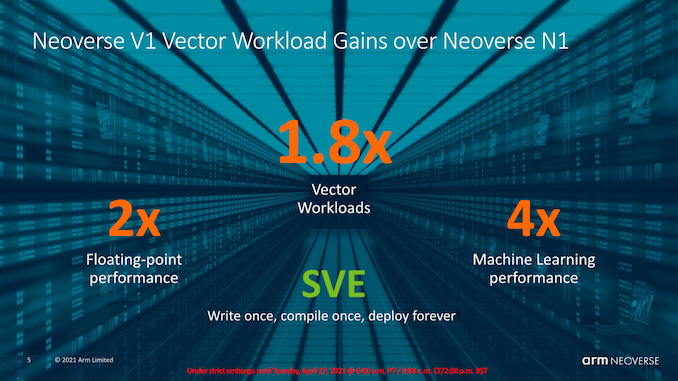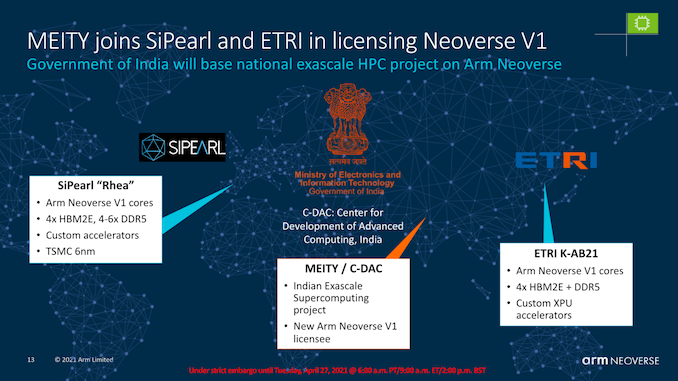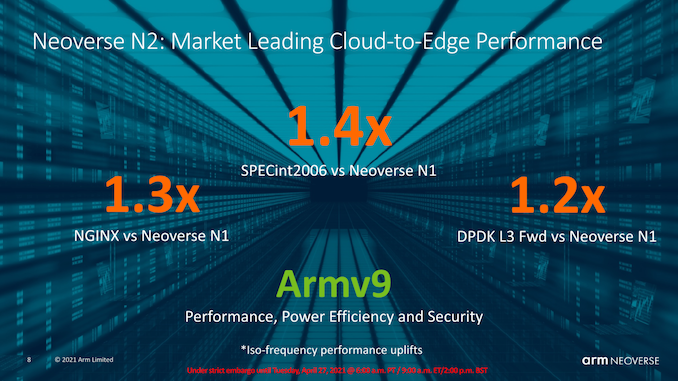Arm Announces Neoverse V1, N2 Platforms & CPUs, CMN-700 Mesh: More Performance, More Cores, More Flexibility
by Andrei Frumusanu on April 27, 2021 9:00 AM EST- Posted in
- CPUs
- Arm
- Servers
- Infrastructure
- Neoverse N1
- Neoverse V1
- Neoverse N2
- CMN-700
First Thoughts & End Remarks
2020 was indeed a super-exciting year for Arm’s server ambitions, and one can easily claims that then Neoverse N1 has been a resounding success and implementations can be seen as being on the same playing field as the best that AMD and Intel are able to achieve, even against today’s newest generations.
The new Neoverse V1 and N2 continue the story in a 2-prong approach. For the Neoverse V1, back when the design was initially teased back in September, I was quite amazed at the claim of +50% IPC. After today’s figures, while the design is still very impressive, the disclosures of the power, area, and resulting power efficiency requirements have somewhat dulled my expectation of the new CPU microarchitecture.
What’s clear about the Neoverse V1 is that this seems to really be an HPC-oriented design. Alongside the known SiPearl Rhea chip, backed by the European Processor Initiative’s goals for HPC uses, Korea’s ETRI (Electronics and Telecommunications Research Institute) also has a V1 designed dubbed “K-AB21” in the works, also with hybrid HBM2E and DDR5 memory. Along with today’s announcement of the V1, India’s Center for Development of Advanced Computing has also announced that they’re a V1 licensee and be using it in an exascale supercomputer project.
Essentially, it seems the V1 will serve as the foundation of many new custom HPC projects, which is a great win both for Arm as an IP vendor, as well as their licensees which are able to build something to their exact needs.
For enterprise and cloud usages, given the CPU’s power efficiency, I now doubt that we’ll somehow see implementations from cloud or merchant silicon vendors such as Amazon or Ampere, particularly because the N2 will be available.
The Neoverse N2 is a more straightforward migration from the N1. IPC is improved by significant amounts which should result in good generational performance increases. I have concerns about power efficiency as the performance increases come at a linear cost of increased power. There’s a one-time opportunity to increase performance in many workloads by closing the power-gap for workloads which do not fully fill the TDP of a system today (while throttling others), however any further performance increases beyond that are dependent on actual good physical implementations by the vendors to fully take advantage of the next-generation process nodes and to execute on those theoretical gains. We’ll see how that will pan out – for now I’ll give the Arm the benefit of doubt, however we’ll also see similar gains in 5nm designs from the likes of AMD. How the competitive situation will end up in 2022 remains to be seen.
Arm had also made a note that while the N2 is a newer generation IP than the V1, roughly a year apart in design, the company actually expects for N2 products to come out only shortly after V1 products, sometime by end of this year. This further enforces my view that we’ll probably not see much V1 designs outside of the HPC market, and that Amazon and Ampere are likely to follow up with N2 based Gravitons and Altras. I want to be explicit here that none of the usual cloud vendors / CSPs / hyperscalers have yet officially commented on what kind of IP they'll be using in the next-generation designs.
The star of the show today was I think the CMN-700, and the vast new flexibility it allows vendors to achieve. The new architectural improvements and the move towards CCIX 2.0 and CXL are definitive big advances that will allow licensees to create more exotic designs. At the very least, it allows for effective usage of chiplet architecture designs, which is a much-needed feature that vendors need to adopt to be able to ensure affordability and manufacturability of products on leading edge nodes.
I’ll be looking forward to new V1 and N2 designs in 2022, and hope we’ll hear more details from licensees through the course of the year.













95 Comments
View All Comments
Oxford Guy - Tuesday, April 27, 2021 - link
‘Fast-forward to 2021, the Neoverse N1 design today employed in designs such as the Ampere Altra is still competitive, or beating the newest generation AMD or Intel designs – a situation that which a few years ago seemed anything but farfetched.’Hmm... That last bit is odd. Either it’s just ‘farfetched’ or it’s ‘expected’.
eastcoast_pete - Tuesday, April 27, 2021 - link
Yes, those slides look very promising; now eagerly awaiting an eventual test of one or two of these in a actual silicone. I guess then we'll see how they measure up.mode_13h - Tuesday, April 27, 2021 - link
Silicone - From Wikipedia, the free encyclopediaNot to be confused with the chemical element silicon.
A silicone or polysiloxane is a polymer made up of siloxane (−R2Si−O−SiR2−, where R = organic group). They are typically colorless, oils or rubber-like substances. Silicones are used in sealants, adhesives, lubricants, medicine, cooking utensils, and thermal and electrical insulation.
eastcoast_pete - Thursday, April 29, 2021 - link
I'll have to take this up with auto-correct. It keeps changing silicon to silicone. Now that I forced it again to leave silicon alone (for the umpteenth time), maybe it will stop (:Mondozai - Tuesday, April 27, 2021 - link
Fantastic overview by Andrew. AT's most underrated reporter. Hopefully he gets more responsibility to cover more things in the future.Linustechtips12#6900xt - Tuesday, April 27, 2021 - link
AGREEDdotjaz - Tuesday, April 27, 2021 - link
Good, finally confirmed N2 is in fact ARMv9 as suspected. Now we'll just have to wait and see how the new mobile counterparts are. Hopefully we'll see some real improvements.It'll be interesting to see how small the new low power v9 core is given that it has to have a 128b SVE2 pipeline instead of 2x64b NEON.
mode_13h - Wednesday, April 28, 2021 - link
> finally confirmed N2 is in fact ARMv9 as suspected.> Now we'll just have to wait and see how the new mobile counterparts are.
> Hopefully we'll see some real improvements.
The data presented on N2 doesn't give me much hope that v9 changed much, besides the feature baseline. I was hoping for something slightly revolutionary, but it's certainly not that.
dotjaz - Thursday, April 29, 2021 - link
> hoping for something slightly revolutionaryWe've known for a couple of years ARMv9 is just ARMv8.x rebased. Your hopes weren't realistic to begin with. Besides, what "revolutionary" features would you expect ISAs to include? Can oyu name one? ARMv8.5a+SVE2 already has everything you need to design an excellent and efficient uarch. Why re-invent the wheel just for the sake of it?
mode_13h - Thursday, April 29, 2021 - link
> We've known for a couple of years ARMv9 is just ARMv8.x rebased.You knew this according to where? It's one thing to assume that, and clearly it wasn't an unreasonable assumption, but it's another thing to *know* it. So, how did you *know* it?
> Besides, what "revolutionary" features would you expect ISAs to include? Can oyu name one?
It's a fair question. Generally speaking, anything that would help improve efficiency. Maybe things like scheduling hints or maybe some kind of tags to indicate memory writes that are thread-private and terminal reads. Just some examples, off the top of my head.
> ARMv8.5a+SVE2 already has everything you need to design an excellent and efficient uarch.
The issue I see is that IPC and efficiency gains are going to become ever more hard-won, so there needs to be some more creativity in redefining the SW/HW interface to unlock further gains. ARMv9 is going to be with us for probably another decade and it could end up having to compete with yet-to-be-identified alternatives like maybe RISC VI or something completely out of left-field. So, I see it as a wasted opportunity. A pragmatic decision, for sure, but a little disappointing.